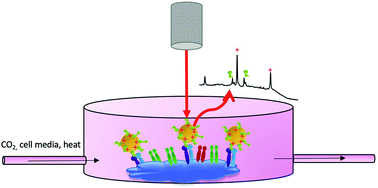Chemical signals are conveyed to cells through ligand–receptor binding, triggering cascades of biochemical reactions and resulting in pivotal cellular functions. These binding events are important in understanding membrane signaling and drug interactions. To probe ligand–receptor binding, surface enhanced Raman scattering (SERS) tags are a promising tool. SERS tags are plasmonic nanostructures functionalized with a protective coating, a Raman reporter molecule, and a biorecognition element. In biological fluids, native proteins have affinity for bare nanoparticles and form a protein corona. SERS tags have a protective shell which eliminates this complication. It is important to analyze ligand–receptor binding with SERS tags in live cells since cell fixatives alter protein structure, leading to spectral changes and data misinterpretation. In this study, we synthesized a novel SERS tag by creating a mixed monolayer of the small cyclic arginine-glycine-aspartic acid-phenylalanine-cysteine (RGDFC) peptide and 4-mercaptobenzonitrile (MBN) on the surface of spherical gold nanoparticles (Au NP). Au-RGDFC-MBN NP showed resistance to PC formation and were successfully detected in both fixed and living human metastatic colon cancer cells.
